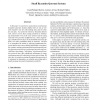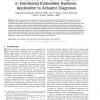DSN
2002
IEEE
15 years 5 months ago
2002
IEEE
In this paper we present two protocols for asynchronous Byzantine Quorum Systems (BQS) built on top of reliable channels—one for self-verifying data and the other for any data. ...
87
Voted
DSN
2002
IEEE
15 years 5 months ago
2002
IEEE
View Synchrony (VS) is a powerful abstraction in the design and implementation of dependable distributed systems. By ensuring that processes deliver the same set of messages in ea...
105
Voted
DSN
2002
IEEE
15 years 5 months ago
2002
IEEE
Concentration of design effort for current single-chip Commercial-Off-The-Shelf (COTS) microprocessors has been directed towards performance. Reliability has not been the primary ...
111
Voted
DSN
2002
IEEE
15 years 5 months ago
2002
IEEE
Standardized 32-bit Cyclic Redundancy Codes provide fewer bits of guaranteed error detection than they could, achieving a Hamming Distance (HD) of only 4 for maximum-length Ethern...
DSN
2002
IEEE
15 years 5 months ago
2002
IEEE
An important aspect in the development of dependable software is to decide where to locate mechanisms for efficient error detection and recovery. We present a comparison between ...
111
click to vote
DSN
2002
IEEE
15 years 5 months ago
2002
IEEE
Model checking has been introduced as an automated technique to verify whether functional properties, expressed in a formal logic like computational tree logic (CTL), do hold in a...
119
Voted
DSN
2002
IEEE
15 years 5 months ago
2002
IEEE
—Advanced automotive control applications such as steer-by-wire are typically implemented as distributed systems comprising many embedded processors, sensors, and actuators inter...
DSN
2002
IEEE
15 years 5 months ago
2002
IEEE
This paper presents the experiences of using a symbolic model checker to check the safety properties of a servoloop control system. Symbolic model checking has been shown to be be...
98
Voted
DSN
2002
IEEE
15 years 5 months ago
2002
IEEE
A virtual duplex system (VDS) can be used to increase safety without the use of structural redundancy on a single machine. If a deterministic program P is calculating a given func...
91
Voted
DSN
2002
IEEE
15 years 5 months ago
2002
IEEE
The architecture and implementation of the LEON-FT processor is presented. LEON-FT is a fault-tolerant 32-bit processor based on the SPARC V8 instruction set. The processors toler...


